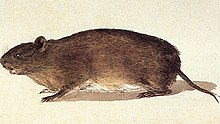| Euryzygomatomys | |
|---|---|

| |
| E. spinosus (1826) | |
|
Scientific classification
| |
| Domain: | Eukaryota |
| Kingdom: | Animalia |
| Phylum: | Chordata |
| Class: | Mammalia |
| Order: | Rodentia |
| Family: | Echimyidae |
| Subfamily: | Euryzygomatomyinae |
| Genus: |
Euryzygomatomys Goeldi 1901 |
| Type species | |
|
Rattus spinosus
G. Fischer 1814
| |
| Species | |
Euryzygomatomys is a genus of South American rodents, commonly called guiaras, in the family Echimyidae. [1] It contains two extant and one fossil species, found in Argentina, Brazil and Paraguay. They are as follows:
- Brandt's guiara (Euryzygomatomys guiara)
- Fischer's guiara (Euryzygomatomys spinosus)
- † Euryzygomatomys hoffstetteri Goeldi 1901 - Tarija Formation, Bolivia [2]
Etymology
The genus name Euryzygomatomys derives from the three Ancient Greek words εὐρύς (eurús, or eury), meaning "wide, or which extends in width", ζύγωμα or ζύγωματος (zúgōma, zúgōmatos), meaning "a part of the forehead, or the zygomatic bone", and μῦς (mûs), meaning "mouse, rat". [3] [4]
Phylogeny
Euryzygomatomys is the sister genus to Clyomys. Both taxa are closely related to the genus Trinomys. In turn, these three genera — forming the clade of Euryzygomatomyinae — share phylogenetic affinities with a clade containing Carterodon and members of the family Capromyidae.
Analyses of craniodental characters proposed that Euryzygomatomys — and also Clyomys — may be associated with Carterodon. [5] [6] However, molecular data suggest the polyphyly of this assemblage of fossorial genera. [7]
| Genus-level cladogram of the Euryzygomatomyinae with their relationship to Carterodon and Capromyidae. | ||
|
| ||
| The cladogram has been reconstructed from mitochondrial and nuclear DNA characters. [8] [9] [10] [11] [12] [7] According to this phylogenetic tree, the fossorial genera Euryzygomatomys, Clyomys, and Carterodon constitute a polyphyletic assemblage (red bar). |
References
- ^ Woods, C.A.; Kilpatrick, C.W. (2005). "Genus Euryzygomatomys". In Wilson, D.E.; Reeder, D.M (eds.). Mammal Species of the World: A Taxonomic and Geographic Reference (3rd ed.). Johns Hopkins University Press. p. 1582. ISBN 978-0-8018-8221-0. OCLC 62265494.
- ^ Tarija at Fossilworks.org
- ^ Bailly, Anatole (1981-01-01). Abrégé du dictionnaire grec français. Paris: Hachette. ISBN 978-2010035289. OCLC 461974285.
- ^ Bailly, Anatole. "Greek-french dictionary online". www.tabularium.be. Retrieved 2017-01-24.
- ^ Carvalho, Guilherme A. S.; Salles, Leandro O. (2004-12-01). "Relationships among extant and fossil echimyids (Rodentia: Hystricognathi)". Zoological Journal of the Linnean Society. 142 (4): 445–477. doi: 10.1111/j.1096-3642.2004.00150.x. ISSN 0024-4082.
- ^ Candela, Adriana M.; Rasia, Luciano L. (2012-02-01). "Tooth morphology of Echimyidae (Rodentia, Caviomorpha): homology assessments, fossils, and evolution". Zoological Journal of the Linnean Society. 164 (2): 451–480. doi: 10.1111/j.1096-3642.2011.00762.x. hdl: 11336/189033. ISSN 0024-4082.
- ^ a b Fabre, Pierre-Henri; Upham, Nathan S.; Emmons, Louise H.; Justy, Fabienne; Leite, Yuri L. R.; Loss, Ana Carolina; Orlando, Ludovic; Tilak, Marie-Ka; Patterson, Bruce D.; Douzery, Emmanuel J. P. (2017-03-01). "Mitogenomic Phylogeny, Diversification, and Biogeography of South American Spiny Rats". Molecular Biology and Evolution. 34 (3): 613–633. doi: 10.1093/molbev/msw261. ISSN 0737-4038. PMID 28025278.
- ^ Galewski, Thomas; Mauffrey, Jean-François; Leite, Yuri L. R.; Patton, James L.; Douzery, Emmanuel J. P. (2005). "Ecomorphological diversification among South American spiny rats (Rodentia; Echimyidae): a phylogenetic and chronological approach". Molecular Phylogenetics and Evolution. 34 (3): 601–615. doi: 10.1016/j.ympev.2004.11.015. PMID 15683932.
- ^ Upham, Nathan S.; Patterson, Bruce D. (2012). "Diversification and biogeography of the Neotropical caviomorph lineage Octodontoidea (Rodentia: Hystricognathi)". Molecular Phylogenetics and Evolution. 63 (2): 417–429. doi: 10.1016/j.ympev.2012.01.020. PMID 22327013.
- ^ Fabre, Pierre-Henri; Galewski, Thomas; Tilak, Marie-ka; Douzery, Emmanuel J. P. (2013-03-01). "Diversification of South American spiny rats (Echimyidae): a multigene phylogenetic approach". Zoologica Scripta. 42 (2): 117–134. doi: 10.1111/j.1463-6409.2012.00572.x. ISSN 1463-6409.
- ^ Fabre, Pierre-Henri; Vilstrup, Julia T.; Raghavan, Maanasa; Der Sarkissian, Clio; Willerslev, Eske; Douzery, Emmanuel J. P.; Orlando, Ludovic (2014-07-01). "Rodents of the Caribbean: origin and diversification of hutias unravelled by next-generation museomics". Biology Letters. 10 (7): 20140266. doi: 10.1098/rsbl.2014.0266. ISSN 1744-9561. PMC 4126619. PMID 25115033.
- ^ Upham, Nathan S.; Patterson, Bruce D. (2015). "Evolution of Caviomorph rodents: a complete phylogeny and timetree for living genera". In Vassallo, Aldo Ivan; Antenucci, Daniel (eds.). Biology of caviomorph rodents: diversity and evolution. Buenos Aires: SAREM Series A, Mammalogical Research — Sociedad Argentina para el Estudio de los Mamíferos. pp. 63–120.